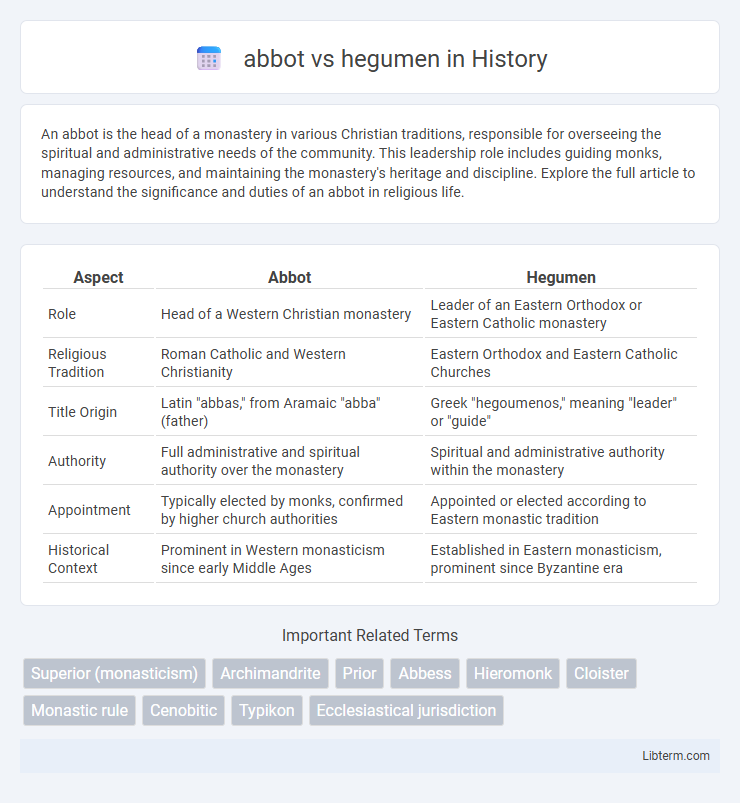An abbot is the head of a monastery in various Christian traditions, responsible for overseeing the spiritual and administrative needs of the community. This leadership role includes guiding monks, managing resources, and maintaining the monastery's heritage and discipline. Explore the full article to understand the significance and duties of an abbot in religious life.
Table of Comparison
| Aspect | Abbot | Hegumen |
|---|---|---|
| Role | Head of a Western Christian monastery | Leader of an Eastern Orthodox or Eastern Catholic monastery |
| Religious Tradition | Roman Catholic and Western Christianity | Eastern Orthodox and Eastern Catholic Churches |
| Title Origin | Latin "abbas," from Aramaic "abba" (father) | Greek "hegoumenos," meaning "leader" or "guide" |
| Authority | Full administrative and spiritual authority over the monastery | Spiritual and administrative authority within the monastery |
| Appointment | Typically elected by monks, confirmed by higher church authorities | Appointed or elected according to Eastern monastic tradition |
| Historical Context | Prominent in Western monasticism since early Middle Ages | Established in Eastern monasticism, prominent since Byzantine era |
Introduction to Abbot and Hegumen
An abbot is the elected head of a monastery in Western Christian traditions, responsible for spiritual leadership and administrative duties within the monastic community. A hegumen, commonly found in Eastern Orthodox and Eastern Catholic Churches, serves a similar role as the superior of a monastery, emphasizing both pastoral care and liturgical oversight. Both titles denote significant authority and spiritual guidance, but their usage varies according to specific ecclesiastical traditions and regional practices.
Historical Origins of Abbot and Hegumen
The historical origins of the abbot trace back to early Christian monasticism in the Egyptian deserts, where the term derives from the Aramaic word "abba," meaning father, signifying the spiritual leader of a monastery. The hegumen, originating in the Eastern Orthodox Church, emerged as the head of a monastery, with roots in Byzantine monastic traditions where the Greek term "hegoumenos" means "the one who is in charge." Both titles reflect distinct religious and cultural lineages influencing monastic governance in Western and Eastern Christian traditions.
Etymology of the Terms
The term "abbot" derives from the Aramaic word "abba," meaning "father," reflecting the role of a male monastic leader in Western Christian traditions. In contrast, "hegumen" originates from the Greek "hegoumenos," meaning "the one who leads," primarily used in Eastern Orthodox monasticism to denote the head of a monastery. Both titles emphasize spiritual leadership but arise from distinct linguistic and cultural origins within Christian monasticism.
Roles and Responsibilities
An abbot is the elected spiritual leader of a monastery in Western Christianity, responsible for governing the community, ensuring adherence to religious rules, and overseeing administrative duties. A hegumen serves a similar role in Eastern Orthodox and Eastern Catholic monastic traditions, primarily focusing on spiritual guidance, liturgical leadership, and maintaining monastic discipline. Both roles require fostering communal harmony and representing the monastery in ecclesiastical matters.
Differences in Religious Traditions
An abbot is typically the head of a Western Christian monastery, especially in the Roman Catholic and Anglican traditions, responsible for spiritual leadership and administrative duties within the abbey. A hegumen serves a similar role in Eastern Orthodox and Eastern Catholic monastic communities, with distinct liturgical practices and monastic rules reflecting Byzantine influences. The key difference lies in their religious traditions, as abbots follow Western monastic customs while hegumens embody the spiritual and cultural heritage of Eastern monasticism.
Abbot in Western Monasticism
The abbot in Western monasticism serves as the spiritual and administrative leader of a monastery, overseeing the daily routines, discipline, and welfare of the monastic community. Rooted in the Rule of Saint Benedict, the abbot holds authority granted through both the monastic tradition and often ecclesiastical endorsement, embodying the ideal of obedience and humility. Unlike the hegumen, whose role is more common in Eastern Orthodox monasticism, the abbot's responsibilities emphasize a hierarchical structure integral to Western monastic governance.
Hegumen in Eastern Orthodoxy
Hegumen in Eastern Orthodoxy refers to the head monk or superior of a monastery, responsible for spiritual guidance and administrative leadership within the monastic community. Unlike an abbot, commonly used in Western monastic traditions, a hegumen often holds a rank below an archimandrite and primarily serves in smaller or less prominent monasteries. The hegumen's duties include overseeing liturgical services, maintaining monastic discipline, and fostering the spiritual growth of monks according to Eastern Orthodox canon law and monastic regulations.
Selection and Appointment Process
The selection and appointment process for an abbot involves a formal election by the monastic community or appointment by higher ecclesiastical authority, often requiring approval from a bishop or synod. In contrast, a hegumen is typically appointed directly by a bishop or a higher-ranking cleric without a community election, reflecting a more hierarchical selection approach. Both roles require candidates to demonstrate spiritual maturity and leadership qualities, but the abbot's appointment emphasizes communal consent while the hegumen's is more centralized.
Authority and Leadership Structure
An abbot holds the highest authority within a monastery, overseeing spiritual guidance, administrative decisions, and the overall community life of monks, often elected by the monastic community. The hegumen, typically found in Eastern Orthodox monasteries, acts as a senior monk or prior, managing daily operations and discipline under the abbot's jurisdiction or in smaller monasteries where the hegumen may function as the head. Authority in monastic leadership is hierarchical, with the abbot embodying supreme governance while the hegumen supports leadership duties and enforces the abbot's directives.
Modern Relevance and Comparisons
The abbot and hegumen both serve as spiritual leaders within Christian monastic traditions, with the abbot primarily associated with Western Catholic monasteries and the hegumen linked to Eastern Orthodox communities. Modern relevance highlights the abbot's role in administrative leadership and external relations, while the hegumen emphasizes pastoral care and liturgical functions within the monastery. Comparisons reveal that despite differences in jurisdiction and ritual, both titles embody the core responsibility of guiding monastic life and preserving religious heritage in contemporary contexts.
abbot Infographic

 libterm.com
libterm.com